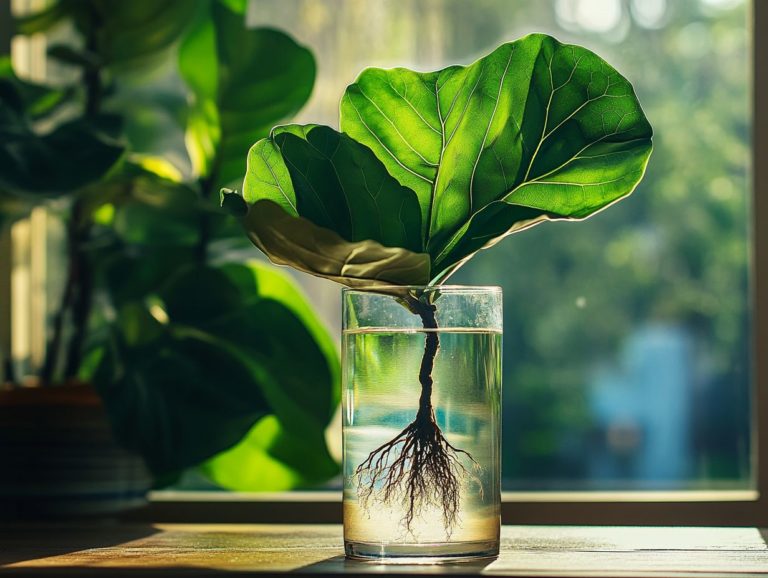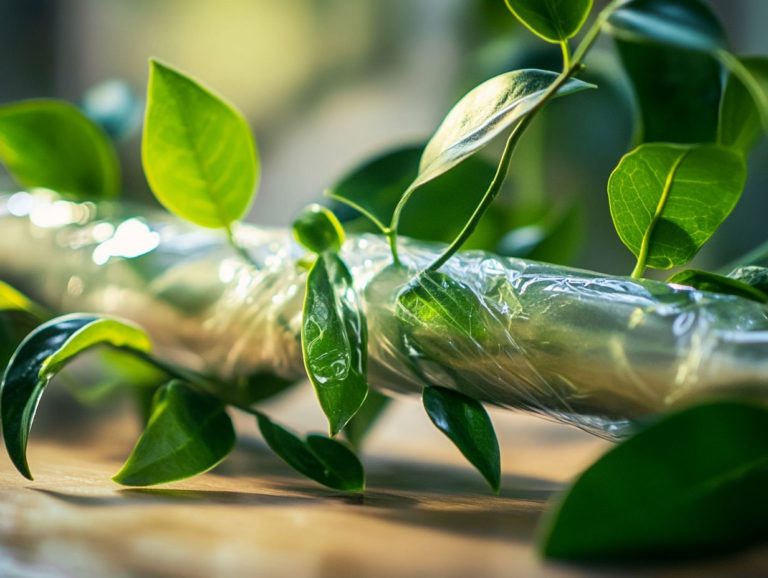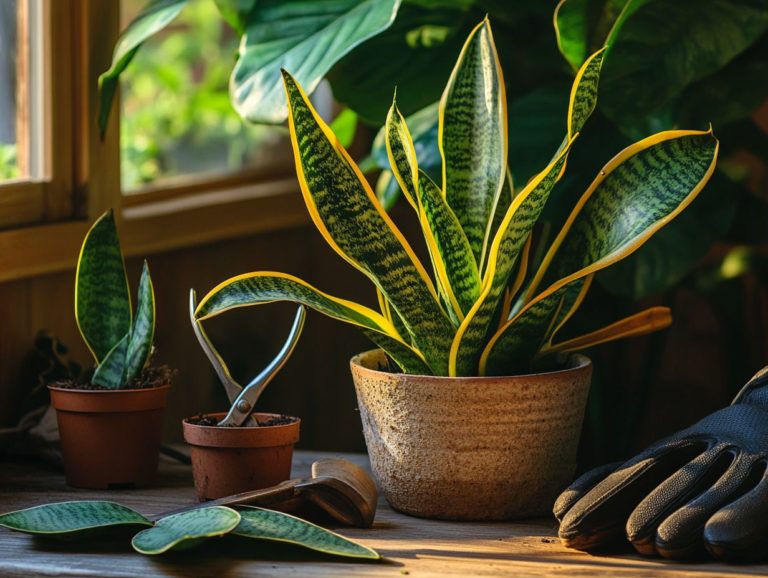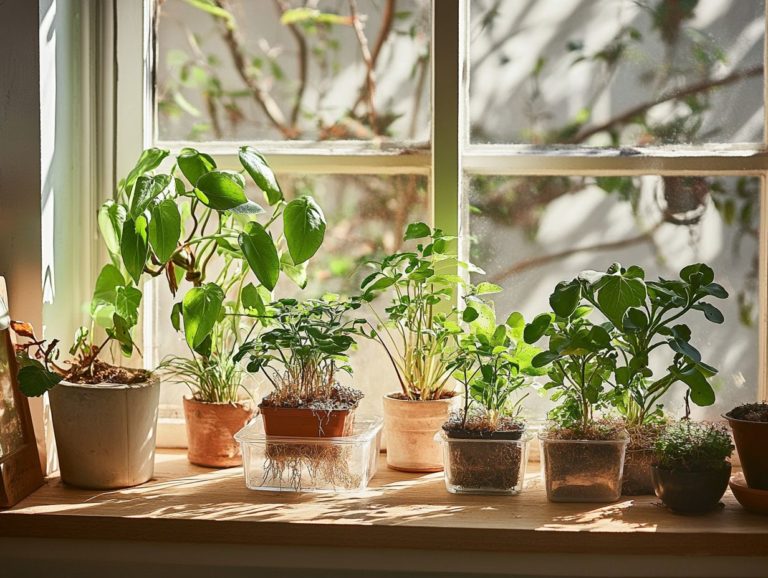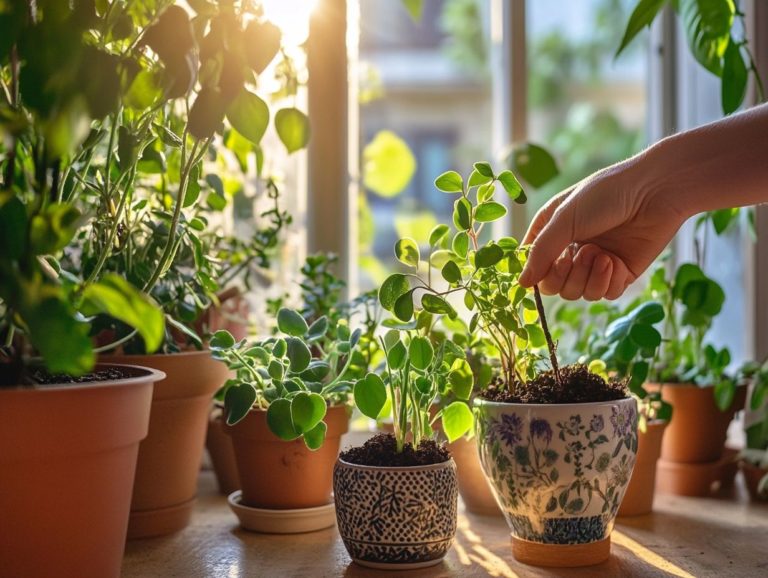How to Propagate Calathea Plants
Are you captivated by the vibrant foliage of Calathea plants? You’re not alone! These stunning houseplants come in many types, each with its own beautiful patterns and colors.
Whether your goal is to expand your indoor jungle or to share their beauty with friends, making more Calathea plants can be an immensely rewarding endeavor.
This guide will walk you through effective methods, including division and stem cuttings, while offering essential tips for preparing your parent plant and caring for your new green companions.
We will also cover common issues that may arise along the way, including plant pests that you should be wary of. Get ready to nurture your beautiful Calathea plants!
Contents
- Key Takeaways:
- Overview of the Plant and Its Varieties
- Methods of Propagation
- Preparing for Propagation
- Step-by-Step Propagation Process
- Caring for Newly Propagated Calathea Plants
- Common Issues and Troubleshooting
- Frequently Asked Questions
- Can I propagate Calathea plants using water?
- When is the best time to propagate Calathea plants?
- How long does it take for Calathea cuttings to root?
- Can I propagate Calathea plants by division?
- Do I need to fertilize newly propagated Calathea plants?
- What is the success rate for propagating Calathea plants?
Key Takeaways:

- Propagate Calathea plants by division or stem cuttings to grow new plants and expand your collection!
- Prepare for propagation by gathering necessary tools and ensuring the parent plant is well-cared for!
- Follow detailed instructions and provide proper care after propagation to ensure successful growth of new Calathea plants!
Overview of the Plant and Its Varieties
The Calathea is a breathtaking tropical plant from Central and South America and other tropical regions. It effortlessly enchants indoor plant aficionados with its vivid leaves and intricate patterns.
This allure makes it a favored addition to houseplant collections. With varieties like Calathea zebrina, C. orbifolia, C. lancifolia, and the exquisite Calathea peacock, each one offers unique beauty.
These decorative perennials flourish with the right care, making them perfect for both novice and seasoned plant enthusiasts seeking beautiful foliage.
Methods of Propagation
Understanding the various methods to grow new plants is key to successfully propagating Calathea plants. This gives you the power to choose between division and stem cuttings with confidence.
Each technique has its own unique advantages and challenges. It’s vital to select the right approach based on your plant’s health and the season.
Summer is the best time for propagation as Calathea becomes especially receptive, offering you the perfect opportunity for vibrant new growth.
Division Method
The division method is a superb way to propagate Calathea. This works well when the plant is crowded, or when the roots are too crowded in the pot. By carefully dividing the root clumps, you ensure each new plant retains a robust root system.
This is vital for establishing and thriving in its new pot. This approach supports healthy plant care and helps maintain optimal soil moisture levels.
To know when it s time to divide, look out for signs like crowded roots or a noticeable drop in growth. Timing matters aim to do this during the growing season.
You ll need a few essential tools:
- A sharp, clean knife or spade
- Gloves
- A potting mix suited for Calathea
Before you start, gently remove the plant from its pot and inspect the roots. Carefully separate them into clumps, ensuring each piece has healthy roots and some foliage.
After repotting, keep a close watch on soil moisture. Overwatering can lead to root rot, while underwatering can stress your new plants. Consistent care paired with the right light and humidity will help them adjust beautifully.
Stem Cutting Method
Using the stem cutting method to propagate your Calathea can yield remarkable results, especially if you re mindful of the plant s specific care requirements and humidity needs. This method involves taking healthy stem cuttings and placing them in a well-suited growing medium that ensures proper soil drainage. This allows the cuttings to root without the risk of becoming waterlogged.
It s essential to maintain high humidity levels. This encourages strong root development and supports your plant care techniques.
To begin, selecting the right stems is paramount. Opt for vibrant, healthy cuttings that show no signs of pests or diseases. Prepare the cuttings by trimming them just below a node to maximize their potential to root effectively. After that, place the cuttings in a well-draining soil mix that will enable excess moisture to escape while still retaining enough water for the roots.
Creating an ideal environment is key. Consider covering the cuttings with a plastic dome or utilizing a humidity tray to elevate moisture levels. By closely monitoring the humidity during this phase, you significantly enhance your chances of successful rooting. This ultimately makes a world of difference in your propagation journey.
Preparing for Propagation

Before you embark on the propagation journey for your Calathea, it’s crucial to gather the right tools and materials. Ensure that the parent plant is healthy and productive to avoid any plant pests.
You ll want to have sharp shears on hand, along with a potting mix that excels in moisture retention and drainage. Don’t forget the containers for rooting those cuttings or divided clumps.
A consistent watering schedule boosts your chances of successful propagation and helps manage soil moisture.
Tools and Materials Needed
To successfully propagate Calathea plants, having the right tools and materials is essential for an efficient and effective process. You’ll want sharp shears for clean cuts, containers for rooting your cuttings or divisions, and a high-quality potting mix tailored for tropical plants that maintains optimal soil moisture.
Among the recommended tools, consider investing in a propagation station or humidity dome. These can significantly boost growth by maintaining moisture levels and creating the perfect microenvironment for rooting.
Choosing sterile potting containers is a smart move as it helps prevent potential diseases that could hinder growth. When selecting your potting mix, go for one that includes peat moss, perlite, or coconut coir; these ingredients promote aeration and drainage, both crucial for preventing root rot.
Ultimately, these thoughtfully chosen tools and materials provide the support necessary for your Calathea plants to thrive throughout their propagation journey. Enjoy their beautiful foliage!
Preparation and Care of Parent Plant
Proper preparation and care of your parent Calathea plant before propagation can greatly influence the success of new growth. Keep a close eye on the watering schedule, humidity levels, and soil nutrients.
During this crucial period, establishing a consistent watering routine is vital. Avoid both overwatering and drought, as Calatheas thrive in evenly moist soil. Aim to maintain humidity levels above 50% to create a nurturing environment for new shoots to flourish. For those interested in expanding their plant collection, learning how to propagate Monstera plants can be an excellent addition to your gardening skills.
Inspect the leaves regularly! Catching pests early, such as spider mites or aphids, as well as symptoms of common diseases like root rot or leaf spot, will further safeguard the health of your parent plant. By meticulously addressing these factors, you set the stage for robust, healthy new growth throughout the propagation process.
Step-by-Step Propagation Process
Adhering to a structured, step-by-step propagation process is essential for ensuring the flourishing growth of your Calathea plants. Whether you choose division or stem cutting, each technique requires your careful attention to detail.
This includes managing soil moisture and maintaining a consistent watering schedule tailored to your plants’ specific needs. Incorporate plant food that helps with growth at the right stages to boost new growth and enhance the vitality of your Calathea! Additionally, learning how to propagate fiddle leaf fig trees can also help you expand your indoor garden.
Detailed Instructions for Each Method
To ensure a successful propagation experience, follow instructions tailored specifically to each method: division and stem cutting. Each approach has unique steps that cater to Calathea’s characteristics and emphasize effective propagation.
By breaking the process down into manageable parts, you can easily propagate these stunning plants with confidence.
For division, start by carefully removing the plant from its pot. Gently separate the root ball into sections, ensuring each section has enough roots and leaves to thrive.
For stem cutting, select healthy stems and make your cut just below a node before planting them in suitable potting mix. After propagation, providing consistent humidity levels, warmth, and filtered light is crucial for exciting growth!
Keep a close eye on the soil moisture to help your plants thrive! Avoid overwatering, as these plants prefer well-draining conditions. With these tips, you’re ready to grow a vibrant Calathea collection. If you’re interested, learn how to propagate spider plants and start your propagation journey today!
Caring for Newly Propagated Calathea Plants

Caring for your newly propagated Calathea plants is essential for establishing a robust root system. It’s important to grasp the best practices for both transplanting and ongoing maintenance.
These young plants require a consistent watering routine. Keep a keen eye on soil moisture levels to avoid the pitfalls of overwatering or underwatering.
By creating the right conditions, you’ll encourage healthy new growth and the vibrant foliage that makes Calatheas so captivating!
Transplanting and Maintenance Tips
Transplanting your newly propagated Calathea plants requires attention to detail, especially regarding soil drainage and watering schedules. The initial weeks post-transplantation are crucial for acclimatization, so diligent maintenance is essential.
Watch for any pesky invaders, as a pest-free environment is key to healthy growth. Choose pots with adequate drainage holes to allow excess water to escape; Calatheas prefer slightly moist, but not soggy, soil.
A potting mix that combines peat, perlite, and orchid bark creates an airy substrate, enhancing drainage while retaining enough moisture.
Establishing a consistent watering routine is vital! Water the plants when the top inch of soil feels dry, usually around once a week, but be prepared to adjust based on your home s humidity levels.
To ward off pests, inspect the foliage regularly for any signs of infestation. A non-toxic remedy like neem oil or insecticidal soap can be your best friend in keeping unwanted guests away.
With the right care, your Calathea will flourish, displaying its stunning leaves and lush beauty throughout your space!
Common Issues and Troubleshooting
Identifying common issues and troubleshooting problems is essential for maintaining the health of your Calathea plants. Their unique sensitivity to their environment requires special attention.
Factors like improper humidity levels, watering errors, and pesky invaders such as spider mites can create obstacles to growth and vitality. Understanding these challenges empowers you to take proactive steps!
With the right strategies, your Calathea thrives beautifully. Start addressing these issues today!
Identifying and Addressing Problems
Identifying and addressing problems early can save your Calathea from serious damage.
Pests and common illnesses threaten its health.
It’s essential to observe your plant closely for signs of distress. Look for symptoms like curling leaves or discoloration so you can intervene promptly.
It’s vital to maintain proper humidity levels, as Calathea plants are especially sensitive to their environment.
A healthy Calathea typically boasts vibrant, lush leaves. If you spot yellowing or brown edges, it may indicate root problems or insufficient moisture.
Don’t forget to check the undersides of the leaves for pests like spider mites or mealybugs. These pests can cause significant issues for your plant.
To combat these problems, maintain a consistent humidity level of at least 50%.
If you encounter pests, consider using insecticidal soap or neem oil as natural treatments. Ensure proper drainage to alleviate any root-related concerns.
Keep a close eye on your plant to help it thrive!
Frequently Asked Questions
Can I propagate Calathea plants using water?
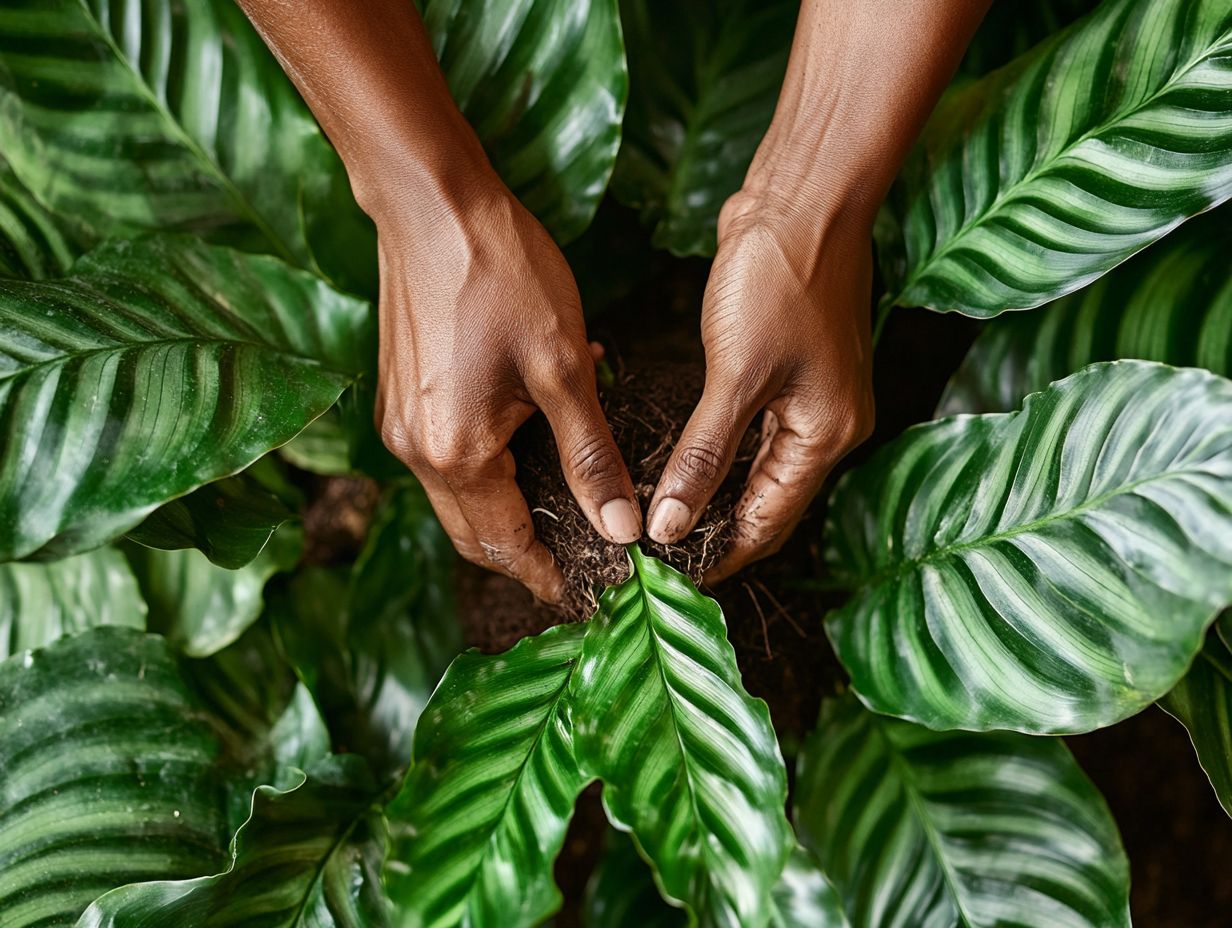
Yes, you can propagate Calathea plants using water. Simply take a healthy stem cutting and place it in a jar of water. Make sure the leaves are above the waterline.
Change the water every few days and wait for roots to develop before transferring to soil.
When is the best time to propagate Calathea plants?
The best time to propagate Calathea plants is in the spring or summer, when the plant is actively growing. This gives the cutting the best chance to establish itself and grow into a healthy plant.
How long does it take for Calathea cuttings to root?
It can take anywhere from 2 to 6 weeks for Calathea cuttings to root. This depends on temperature and humidity levels.
You can speed up the process by keeping the cutting in a warm, humid environment and using a rooting hormone.
Can I propagate Calathea plants by division?
Yes, you can propagate Calathea plants by division. This involves separating a healthy, established plant into smaller sections and replanting them.
Ensure each section has its own stem and root system for the best chance of survival.
Do I need to fertilize newly propagated Calathea plants?
No, you do not need to fertilize newly propagated Calathea plants. The cutting has enough nutrients stored in its stem and leaves to sustain itself until it develops a strong root system.
You can start fertilizing once the plant is established and actively growing.
What is the success rate for propagating Calathea plants?
The success rate for propagating Calathea plants varies, but on average it is around 50-70%.
Factors such as temperature, humidity, and care can greatly impact the success of propagation. Keep a few extra cuttings to increase your chances of success.
Start propagating your Calathea today for a lush indoor garden!

